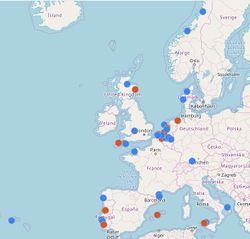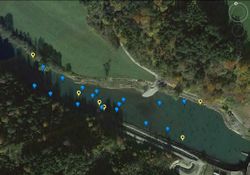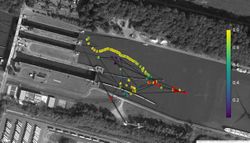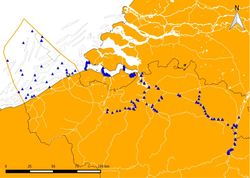Acoustic telemetry
Contents
Quick summary

Developed by:
Date:
Type: Method
Introduction
Together with radio and PIT telemetry, acoustic telemetry is a biotelemetry technique that has been used on fish for over 60 years. The principle of acoustic telemetry consists of the communication between an emitting tag (fish) and a receiving device (hydrophone) by means of an acoustic signal to determine the location of the tag (fish). This location can provide useful information about migration, individual behaviour, habitat use, passage efficiency, predation, etc. Acoustic telemetry uses lower radio frequency signals (69-500 kHz) compared to radio telemetry (30-300 MHz), which both have advantages and disadvantages. A major drawback of acoustic compared to radio telemetry used to be the poor reading range in turbulent water systems. Recent developments countered this drawback by using higher frequency signals. Nowadays, also more challenging environments like noisy, shallow and reflective water systems are suitable for acoustic telemetry. This evolution also allows positioning many tagged animals with sub-meter accuracy at the same time. Another unique advantage of acoustic telemetry is its capability to be used in salt and deep water. These features make this technique suitable to conduct fish behaviour studies that are able to address multiple research questions, even for diadromous fish species. Besides a single registration of a fish (1D or presence/ absence), more and more research is done to gather fish tracks in 2D or even 3D at specific sites like migration obstacles, fish passes and hydropower stations (Figure 3). The principle of this precise positioning of fish is based on the difference in detection time of a tag that is positioned in between at least 3 receiving hydrophones. Depending on the producer of the tags and hydrophones, the acoustics work at different kHz ranges. When the producer is VEMCO, then the 2D/3D positioning system is called VPS and this works at either 69 kHz or 180 kHz. Initially, this VPS (Vemco Positioning System) was mainly used in big lakes using 69 kHz tags, but recently small-scale accurate fish tracking is possible using a higher 180 kHz frequency. The choice for one or the other frequency depends on the system studied and the study objectives. Typically, the VPS array is equipped with reference and synchronisation tags to monitor system performance and to correct for clock drift between different submerged hydrophones. Figure 1 and 2 show a VPS array conducted at the Fithydro case study of the river Iller (Altusried, Germany) and another one in the Albert Canal (Ham, Belgium).
Application
The most comprehensive use of acoustic fish telemetry has been done on the large scale 1D migration research. In this setup hydrophones are spread along a lake, a river or a canal and fish are detected when passing these hydrophones. Numerous examples of fish migration studies in large rivers and lakes around the world have been published so far. The advantages of this research technique are found in its good performance in deep and salt water and its large detection range in such situations. Many of these migration studies were conducted on diadromous fish species like eel and salmonids. The typical study design consists of 69 kHz hydrophones and tags with a diameter between 7 and 13 mm. The hydrophones can be moored close to the river banks if the detection range of the tags covers the whole width of the river. In lake or estuary systems, hydrophones can be attached to buoys. This range depends on the tag output power (136-162 dB) and the environmental conditions (noise). Tags are custom-made and programmed to fit the research demands. The determining factors for the setup of a 1D acoustic system are the fish species of interest, its environment and the specific research questions. When studying smaller species or juvenile fish, tag size will limit the battery life. Big rivers with strong currents will require more hydrophones and/or tags with a higher output (so a shorter battery life). When spatial and temporal changes of a certain migration are expected, tags could be programmed in different steps in which the duration, the power output and the signal delay can be changed. During or after the study period, hydrophones have to be lifted for data download by means of Bluetooth connection to a PC. Hydrophones at 69 kHz can operate for more than one year before the battery has to be changed. A single hydrophone can store 1.6 million detections. These unique detections are the result of a so called ‘PPM’ signal (Pulse Position Modulation), which is a ping train of 8 consecutive pings. The separation between each of these individual pings results in a unique ID. The recently developed tags and hydrophones that work on 180 kHz can emit and detect HR (High Residency) coded signals beside PPM coded signals. An HR coded signal is emitted as one ping and does not exist of consecutive ping trains. Hence, the emission time of the code is reduced much and one signal is emitted in less than one second. Consequently, the chance of collision of codes of multiple tagged fish that are within the same detection zone of a hydrophone is reduced. Next, the delay between two consecutive code emissions can be reduced as well, down to one second, allowing more frequent fish positioning (more fish positions per time unit). High frequency tags are smaller compared to the 69 kHz tags (smallest tag diameter is 4 mm). A network of receivers can be used to conduct research on several species at a large scale (Figure 3 and 4).
Relevant mitigation measures and test cases
Other information
Acoustic fish telemetry suppliers worldwide:
- ATS, 470 First Avenue NW, Isanti, MN 55040, USA
- HTI, 715 NE Northlake Way, Seattle, WA 98105: recent partnership with Vemco
- Lotek Wireless Inc., 115 Pony Drive, Newmarket, Ontario, Canada L3Y 7B5
- Thelma Biotel, Sluppenveien 10, 7037 Trondheim, Norway, EU
- Sonotronics, 3169 S Chrysler Ave, Tucson, AZ 85713, USA
- Vemco, 20 Angus Morton Drive, Bedford, Nova Scotia, Canada B4B 0L9
Hydrophones can differ regarding the frequency used, the ability to measure other variables (tilt, temperature, …), whether it is cabled or not, etc. The price for one submersible hydrophone ranges from 1.000 to over 3.000 € (without VAT). Tags are available in an endless number of different settings and sizes. The price range of acoustic tags is between 180 and 500 €. A lot of other gear like portable hydrophones, automatic acoustic release systems, remote communication, etc. are available these days.
Relevant literature
Some examples of 1D acoustic studies using different suppliers of acoustic gear:
- Bass, A. L., T. O. Haugen, & L. A. Vøllestad, 2014. Distribution and movement of European grayling in a subarctic lake revealed by acoustic telemetry. Ecology of Freshwater Fish 23: 149–160.
- Behrmann-Godel, J., & Eckmann, R., 2003. A preliminary telemetry study of the migration of silver European eel (Anguilla anguilla L.) in the River Mosel, Germany. Ecology of Freshwater Fish 12: 196–202.
- Besson, M., T. Trancart, A. Acou, F. Charrier, V. Mazel, A. Legault, & E. Feunteun, 2016. Disrupted downstream migration behaviour of European silver eels (Anguilla anguilla, L.) in an obstructed river. Environmental Biology of Fishes .
- Breine, J., I. S. Pauwels, P. Verhelst, L. Vandamme, R. Baeyens, J. Reubens, & J. Coeck, 2017. Successful external acoustic tagging of twaite shad Alosa fallax (Lacépède 1803). Fisheries Research 191: 36–40.
- Bultel, E., Lasne, E., Acou, A., Guillaudeau, J., Bertier, C., & Feunteun, E. (2014). Migration behaviour of silver eels (Anguilla anguilla) in a large estuary of Western Europe inferred from acoustic telemetry. Estuarine, Coastal and Shelf Science, 137(0), 23-31. doi:http://dx.doi.org/10.1016/j.ecss.2013.11.023
- Hayden TA, Holbrook CM, Fielder DG, Vandergoot CS, Bergstedt RA, Dettmers JM, et al. (2014) Acoustic Telemetry Reveals Large-Scale Migration Patterns of Walleye in Lake Huron. PLoS ONE 9(12): e114833. https://doi.org/10.1371/journal.pone.0114833
More than 1000 research papers on Vemco acoustic telemetry research can be consulted via https://vemco.com/publications-database/.
Hundreds of papers that used Lotek gear can be found here: http://www.lotek.com/search
Examples of 2D and 3D research outputs:
- Andrews, K. S., N. Tolimieri, G. D. Williams, J. F. Samhouri, C. J. Harvey, & P. S. Levin, 2011. Comparison of fine-scale acoustic monitoring systems using home range size of a demersal fish. Marine Biology 158: 2377–2387.
- Espinoza, M., T. Farrugia, D. Webber, F. Smith, & C. Lowe, 2011. Testing a new acoustic technique to quantify fine-scale, long-term fish movements. Fisheries Research 108: 364-371.
- Fowler, A. J., C. Huveneers, & M. T. Lloyd, 2017. Insights into movement behaviour of snapper (Chrysophrys auratus, Sparidae) from a large acoustic array. Marine and Freshwater Research 68: 1438–1453.
- Roy, R., L. Westrelin, E. Tissot, E. De Oliveira, & C. Argillier, 2014. Activity patterns of three piscivorous species in a reservoir studied with the Vemco Positioning System. 144ème réunion annuelle de l’American Fisheries Society 18 p.
- Vergeynst, J., R. Baeyens, I. Pauwels, T. De Mulder, I. Nopens, & A. Mouton, 2016. The behaviour of downstream migrating European eel at sluices and turbines. http://lib.ugent.be/catalog/pug01:8075115.
- Williams-Grove, L. J., & S. T. Szedlmayer, 2017. Depth preferences and three-dimensional movements of red snapper, Lutjanus campechanus, on an artificial reef in the northern Gulf of Mexico. Fisheries Research 190: 61–70.


